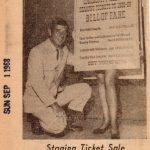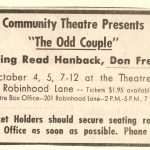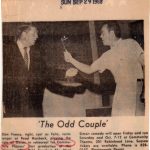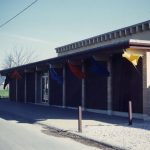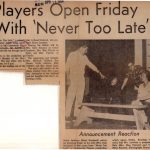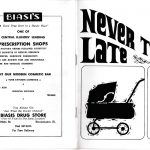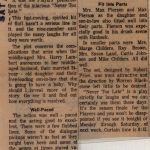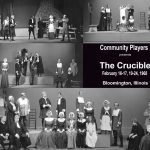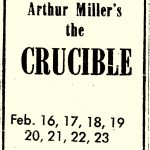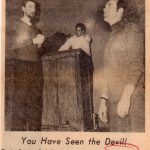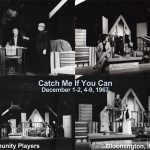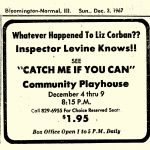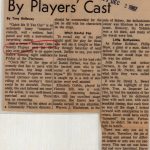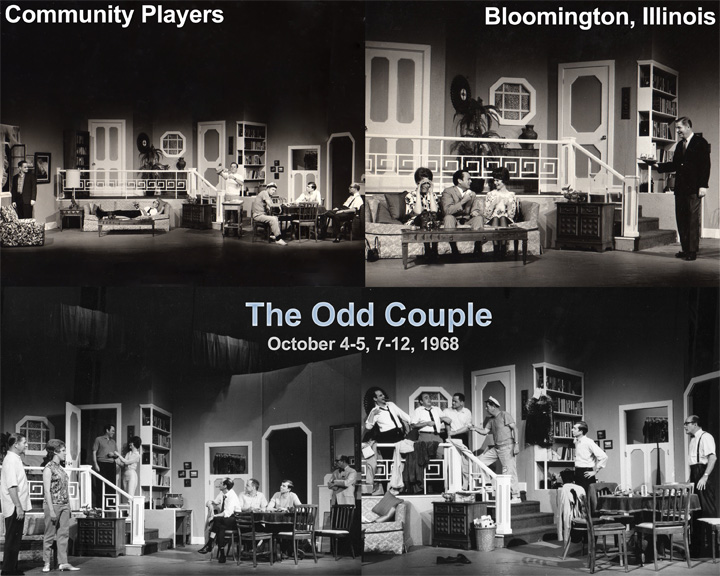
The Odd Couple (1968)
Performances
October 4-5, 7-12, 1968
Venue
Community Players Theatre
Synopsis
“The Odd Couple” tells the story of Felix Unger, a neurotic, neat freak who is thrown out by his wife and moves in with his divorced friend Oscar Madison, a slovenly sportswriter. Despite Oscar’s problems—careless spending, excessive gambling, a poorly-kept house filled with spoiled food—he seems to enjoy life. Felix, however, seems utterly incapable of enjoying anything and only finds purpose in pointing out other people’s mistakes and foibles. Even when Felix tries to do this in a gentlemanly manner, he is still extremely annoying to those around him. Oscar, his closest friend, feels compelled to finally throw Felix out after only a brief time together, though he realizes Felix has had a positive effect on him.
Author: Neil Simon
Historian’s Corner
By the opening of the production “The Odd Couple,” Players had sold 2,216 season tickets for the 1968-1969 season. This total would be one of the highest totals for season tickets in Players’ history. A special feature of the program was the inclusion of a section titled “Nostalgia.” Beginning with “the Odd Couple” program, then Players’ historian, Dr. Wilson Baltz gave a brief history of Community Players. Each program that season featured a history of Community Players by decade. “The Odd Couple” started with the founding of the Community Players in 1923 and continued on until the end of the 1932-1933 season.
Cast
Crew

Never Too Late
Performances
April 19-20, 22-27, 1968
Venue
Community Players Theatre
Synopsis
“Never Too Late” is about a married man who, in his fifties, suddenly learns he is becoming a father again. Harry’s last child, a girl, was born 24 years ago and considering the boob she married, Harry finds the prospect of another child unthinkable. His daughter and son-in-law live with Harry: she gets up for breakfast at noon and he is curiously addicted to solitaire. It is not only the impending birth that startles Harry; his previously meek wife begins to lay down the law. There is to be a nursery, a new bath, and she is to have her own checking account. Such dour capitulation you’ll never see again. This show was a Broadway success of an old fashioned domestic farce that had a long run. “Never Too Late” was also successful in dinner theaters and community theaters across the county in the mid-1960’s.
Author: Sumner Arthur Long
Historian’s Corner
“Never Too Late” closed out the 45th Season at Players with the highest single admission ticket sales other than “Damn Yankees.” The final total was $977 in single admissions. The production staff kept the costs well below their budget, which also factored into making this show the most successful play of the season.
Cast
Crew
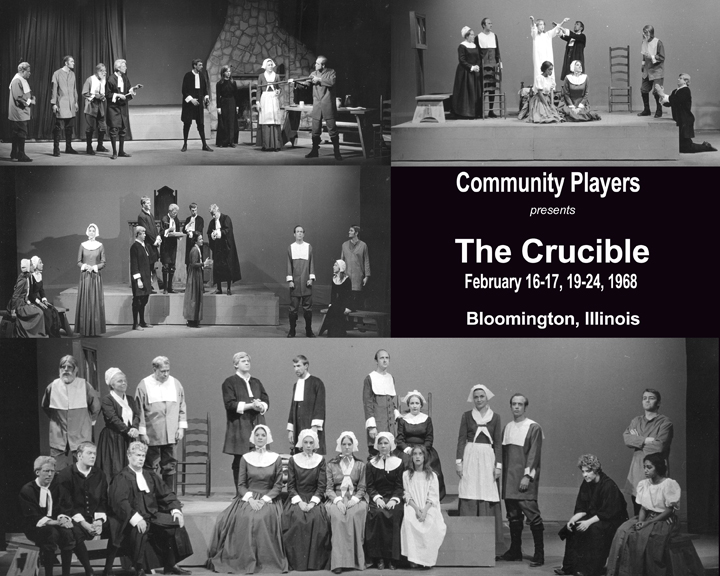
The Crucible (1968)
Performances
February 16-17, 19-24, 1968
Venue
Community Players Theatre
Synopsis
“The Crucible” by Arthur Miller is a dramatic re-enactment of The Salem Witch Trials in Massachusetts in the late 1600’s. Although the play centers on real events, it is not an actual ‘history.’ Miller changes the ages of characters and consolidated several historical figures so that there would be fewer actors on the stage. The play was first produced in 1953 as an allegory to Senator Joseph McCarthy’s hearings on the anti-communism scare of the era. “The Crucible” is a play about fear and suspicion run amok not only in the 1600’s or the 1950’s, but fears that continue with generations since.
Author: Arthur Miller
Historian’s Corner
For the opening of the production “The Crucible,” Players used their brand new lighting board that had been created by board member Art Lee. Art, who worked for General Electric, created the board with the help of their Industrial Design Department. Thanks to their efforts, Community Players was to get a new, solid-state lighting board that would triple their lighting abilities as well as increase their flexibility when lighting a show. Design work for the lighting board had begun a year earlier in February of 1967. Players final cost would be close to $1,000. On in the open market, a similar lighting system would have cost around $29,000. This system worked for Players for close to ten years before it was finally replaced in 1976.
One problem with any new type of lighting system was working the bugs out of the system, and during the witch trials, the lights created almost psychedelic effects at times. All of the bugs were worked out of the system by the final production of the season. Some remnants of this old system can still be found above the offstage right exit on the south side of the building above the old lighting dock. There are also pieces in the shop basement against the east wall.
Cast
Crew
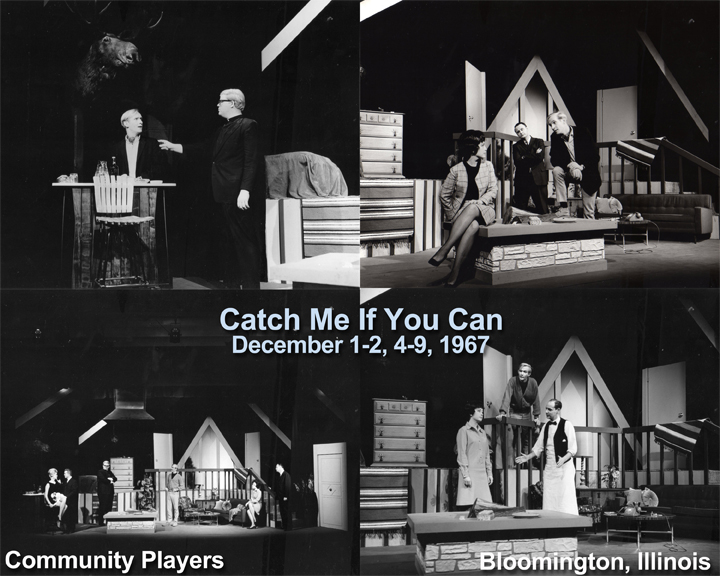
Catch Me If You Can
Performances
December 1-2, 4-9, 1967
Venue
Community Players Theatre
Synopsis
“Catch Me If You Can” tells the story of an advertising man who has brought his bride to his boss’ mountain lodge for a honeymoon but has to call in the local police to investigate his wife’s sudden disappearance. Enter a pretty, young girl who insists, over his protests, that she is the missing wife. A priest backs up her story. A funny, little man who owns a delicatessen enters and before you know it, there are two murders at the isolated lodge.
Authors: Jack Weinstock and Willie Gilbert
Historian’s Corner
“Catch Me If You Can” was the directing debut for Dan Gehrt. Dan had been a part of Community Players since 1962 with the production of “The Desperate Hours” in which he played the leading part of Glenn Griffin, the escaped murderer. Dan became the President of Community Players for the 1968-1970 seasons. Dan’s last active show was in the 1973 production of “What Did We Do Wrong?” In 1982, after an absence of nine seasons, Dan returned to Players in the role of Mr. Jordan in the comedy-fantasy, “Heaven Can Wait”.
